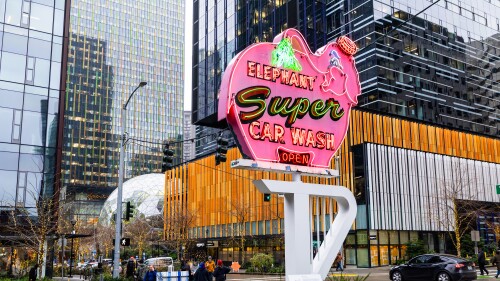
Welcome to the re:Invent Stairway! It’s named after AWS re:Invent, a learning conference hosted for the global cloud computing community.
If you haven’t gone up the stairs yet, back track down 8th Avenue a few steps. You’ll notice an Amazon Lockers location with bottles in the window. This is our little bottle museum of bottles found during the construction of re:Invent the building. These bottles are artifacts of Seattle’s history, dating back to the original Denny regrade project which leveled the neighborhood.
Denny Hill was 190-feet tall and formed by glaciers between 12,000 and 15,000 years ago. While the city of Seattle grew around it, it became a major hindrance to transportation and commercial development in the 1800s. The City Engineer, Reginald Heber Thomson, began leveling in 1898, with the regrade project being completed in December 1930 with the leveling of Denny Park. Many of these bottles displayed in the museum date back to that time period.
Before walking up the stairway to the re:Invent plaza, you’ll notice a small and strange looking parking entrance called the Loading Dock just past the end of the planters. This Loading Dock isn’t for cars but for bikes! Keeping thousands of parked bikes off the streets and providing covered parking is just one way that Amazon is encouraging our employees to take an eco-friendly route to work. Inside our buildings we have showers and clean towels available for employees to clean up after their bike to work.
Depending on the day you’re visiting, a local artist might be putting in a temporary mural on the re:Invent stairs. Amazon loves inviting artists into our headquarters space. Complementing the water fountain, plantings on the hill celebrate the flora of Asia with a diverse collection of woodland plants. Many of the plants visible here were propagated from wild collections and curated by botanical partners.
Many of these plants are rare both in cultivation and in the wild, where native populations are at risk due to human impact. Responsibly propagating these plants can contribute to their conservation outside of their natural habitat, efforts that can be continued in botanical gardens or even in your own home garden.








